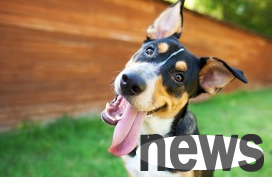Sometimes dogs pant for no reason, but panting is a common dog behavior and there is always a reason. Understanding why dogs are gasping, maybe excessive gasping, or maybe at night, we need to consider what might happen to the dog at this time. Are they anxious? Hot? Dehydration? Understand common reasons for dogs to breathe so that we can respond appropriately.

What is dog gasping?
Moderate to rapid mouth-opening breathing is a normal behavior for dogs and puppies. It can lower body temperature and also allow oxygen to enter the dog's blood. The breathless dog breathed with his mouth open, his tongue protruding a little. Gasp is necessary as a cooling mechanism because dogs do not have the sweat gland system as effective as humans. Instead, the dog uses moisture in the mouth and tongue to evaporate and cools the body by exchanging hot air from the lungs with cooler external air.
Panitation should not be confused with dyspnea. Difficulty breathing is characterized by tension and may be accompanied by painful sounds such as crying or whimpering, or whistling from the nostrils or trachea due to blockage.
Common Causes of Gasing Your dog or puppy may be out of breath for one of these five reasons.
1. Gasp due to exercise
Even if they are not overheated, dogs will gasp due to exercise. This is much like the way humans breathe heavily when they do aerobic exercise. However, breathing is also the main way dogs calm themselves down because they don’t sweat like humans. Although dogs' paw pads do sweat, this doesn't cool them down adequately. Instead, the dog cools itself through its mouth.
Puffing allows the dog to release heat and exchange it for colder air. As you might imagine, this is not a very effective process. It is less efficient for short-faced dogs (such as bulldogs or pugs). This is why dogs start to breathe even if they are a little hot. The hotter the dog becomes, the more intense the gasps become. Sometimes heavy gasps are accompanied by drooling and redness of tongue and gums.
In addition to deep breathing, warning signs of overheating include bright red tongue and gums, wide eyes and weakness. Take steps to keep your dog cool and minimize heat to prevent overheating. Always take caution to keep your dog safe during hot weather. Never leave your dog alone in the car, as the car will quickly become much hotter than the outside world. If in doubt, take your dog to the veterinary for treatment.
Tip: When the outside temperature is equal to or higher than the puppy's normal body temperature 102°F, panting will not effectively cool the puppy and may cause heat stroke. Hot dogs may also turn to digging, digging out cool places to rest.

2. Excitement or stress
Gasming may not be related to body temperature. Many dogs get out of breath when experiencing fear, anxiety, or stress. Examples include rides, fireworks, separation anxiety, visiting a veterinary doctor, and other stressful events. Check your dog's body language to help you determine if your dog is showing signs of fear or any other type of pain. Understanding the causes of your dog’s fear or anxiety can help you minimize these events. If breathing seems to be related to fear, anxiety, or stress, it is best to keep your dog away from this as soon as possible.
3. Many dogs pant while playing
Gasp may just be a sign of your dog's happiness. If so, the rest of your dog's body language will reflect this happy mood. The tail usually sways in a happy way. Your dog's body and facial features will be a little relaxed. The eyes will appear bright and happy. Once things calm down, the breathing slows down and eventually stops. In a relaxed, contented dog, it is normal to keep breathing slightly with open mouth and bright eyes. In fact, many people think it is a dog's smile.